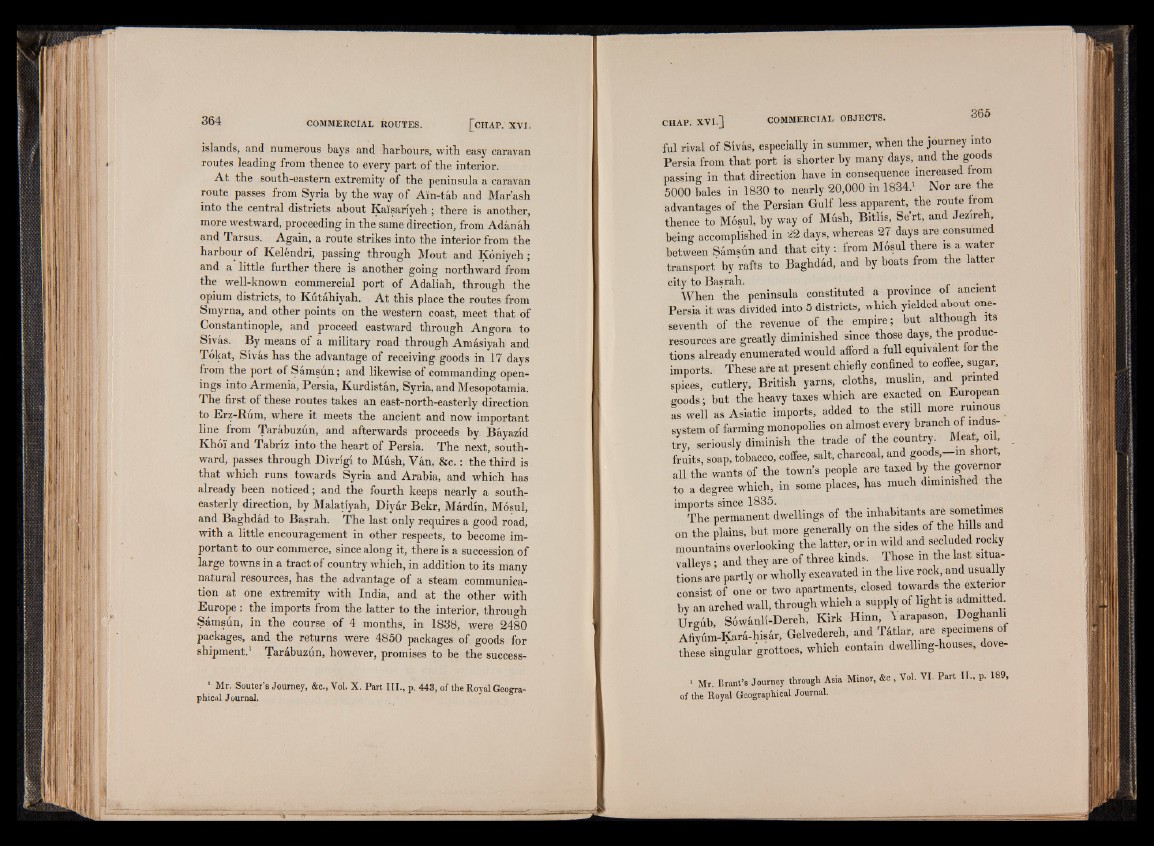
islands, and numerous bays and harbours, with easy caravan
routes leading from thence to every part of the interior.
At the south-eastern extremity of the peninsula a caravan
route passes from Syria by the way of Ain-táb and Mar’ash
into the central districts about Ka'fsariyeh ; there is another,
more westward, proceeding in the same direction, from Adánáh
and Tarsus. Again, a route strikes into the interior from the
harbour of Keléndri, passing through Mout and Kóniyeh;
and a little further there is another going northward from
the well-known commercial port of Adaliah, through the
opium districts, to Kutahiyah. At this place the routes from
Smyrna, and other points on the western coast, meet that of
Constantinople, and proceed eastward through Angora to
Sívás. By means of a military road through Amásiyah and
Tokat, Sívás has the advantage of receiving goods in 17 days
from the port of Sámsún; and likewise of commanding openings
into Armenia, Persia, Kurdistan, Syria, and Mesopotamia.
The first of these routes takes an east-north-easterly direction
to Erz-Rum, where it meets the ancient and now important
line from Tarábuzún, and afterwards proceeds by. Báyazíd
Khói and Tabriz into the heart of Persia. The next, southward,
passes through Divrigi to Músh, Van, &c.: the third is
that which runs towards Syria and Arabia, and which has
already been noticed; and the fourth keeps nearly a southeasterly
direction, by Malatíyah, Diyár Bekr, Márdín, Mosul,
and Baghdad to Basrah. The last only requires a good road,
with a little encouragement in other respects, to become important
to our commerce, since along it, there is a succession of
large towns in a tract of country which, in addition to its many
natural resources, has the advantage of a steam communication
at one extremity with India, and at the other with
Europe : the imports from the latter to the interior, through
Sámsún, in the course of 4 months, in 1838, were 2480
packages, and the returns were 4850 packages of goods for
shipment.1 Tarábuzún, however, promises to be the success1
Mr. Souter's Journey, &c., Vol. X. Part III., p. 443, of the Royal Geographical
Journal.
ful rival of Sivâs, especially in summer, when the journey into
Persia from that port is shorter by many days, and the goods
passing in that direction have in consequence increased from
5000 bales in 1830 to nearly 20,000 in 1834.1 Nor are the
advantages of the Persian Gulf less apparent, the route from
thence to M6sul, by way of Müsh, Bitlis, Se’rt, and Jezu-eh
being accomplished in 22 days, whereas 27 days are consumed
between Samsfin and that city : from Mosul there is a water
transport' by rafts to Baghdâd, and by boats from the latter
city to Basrah. . r . ,
When the peninsula constituted a province ol ancient
Persia it was divided into 5 districts, which yielded about one-
seventh of the revenue of the empire ; but although its
resources are greatly diminished since those days, the productions
already enumerated would afford a full equivalent for the
imports. These are at present chiefly confined to coffee, sugar,
spices, cutlery, British yarns, cloths, muslin, and pnnte
goods; but the heavy taxes which are exacted on European
as well as Asiatic imports, added to the still more ruinous
system of farming monopolies on almost every branch of industry,
seriously diminish the trade of the country Meat oil,
fruits, soap, tobacco, coffee, salt, charcoal, and goods —in short,
all the wants of the town’s people are taxed by the governor
to a degree which, in some places, has much diminished the
imports since 1835. WÊËm
The permanent dwellings of the inhabitants are sometime
on the plains, but more generally on the sides of the hills an
mountains overlooking the latter, or in wild and secluded rocky
valleys ; and they are of three kinds. Those in the last situations
are partly or wholly excavated in the live rock, and usually
consist of one or two apartments, closed towards the exterior
by an arched wall, through which a supply of light is admitted.
Urgub, Sôwânli-Dereh, Kirk Hinn, \ arapason, Doghanli
Afiyüm-Karâ-hisâr, Gelvedereh, and Tâtlar are specimens of
these singular grottoes, which contain dwelling-houses, dove-
‘ Mr. Brant’s Journey through Asia Minor, &c , Vol. VI. Part II., p. 189,
of the Royal Geographical Journal.